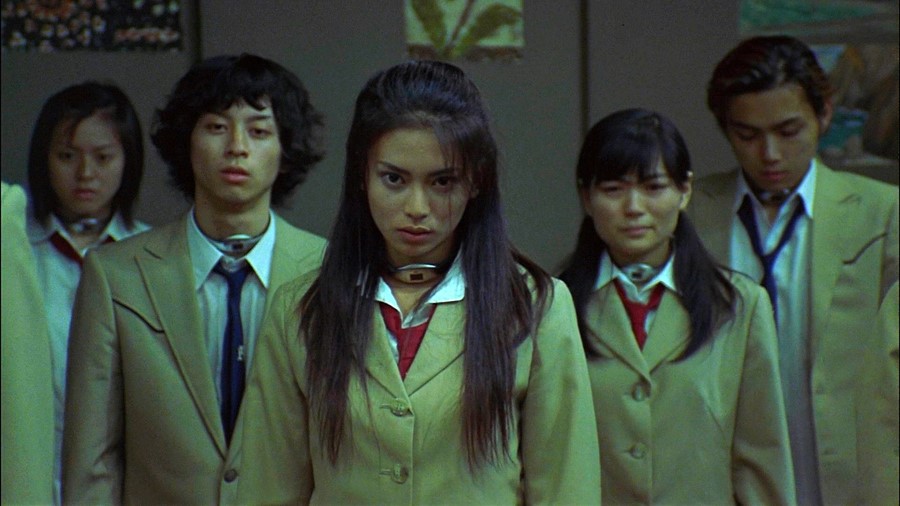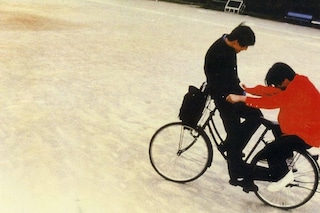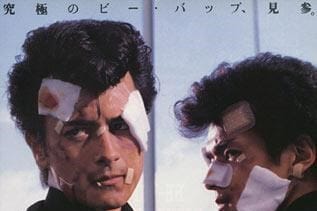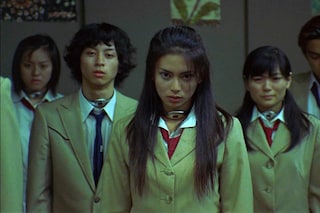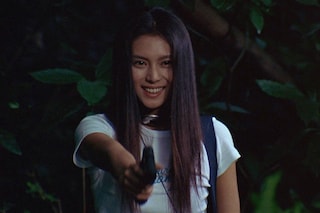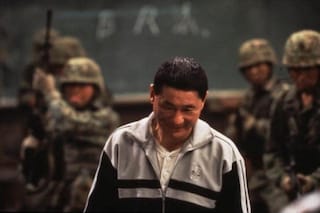Works by Takashi Miike, Toshiaki Toyoda, and Kinji Fukasaku reveal a generation gone wild on the fringes of a corrupted society
With the US election passing, the Brexit deadline looming, and anxieties over Christmas separation lingering, it’s safe to say that 2020 has been a year of division. But with the first COVID vaccines now hitting the headlines, the world economies, at least, seem to be bouncing back. Japan’s Nikkei Stock Average index skyrocketed by 11 per cent in late October to reach levels not seen for 30 years. And yet, despite these soaring figures, the people remain wary.
Understand why: the last time these numbers were seen on the Japanese stock market was in May 1991 – the year the country’s bubble economy burst, plunging a technologically advanced global power into a decade-long recession marred by social turmoil. For a society as deeply competitive as Japan’s, the prospect of record-high unemployment proved catastrophic for the youth.
As employment rates for universities sunk to just 66 per cent by 1998, children found themselves no longer able to meet the standards set by their parents. Schools became increasingly violent as bullying turned rife. Arrests of minors for serious crimes doubled. And heinous cases such as the 1997 Kobe Child Murders dominated news headlines. In a 1999 study, the New York Times concluded that “Japan’s Troubling Trend (of) Rising Teen-Age Crime” was a byproduct of the country’s single-minded industriousness; “the gutting of family life and playtime in the name of workplace performance and school achievement.”
All the while, a thriving film industry – highlighted by major international film festival wins in 1997 and the popular J-horror trend kick-started by The Ring – found emerging indie directors keen to capture the zeitgeist. “We have to make movies that appeal (to younger audiences) and reflect the world they’re living in,” said director Shinji Iwai in 1995.
But the Y2K juvenile delinquency movie in Japan wasn’t so much a fad – it was a major career stepping stone for the country’s fledgling filmmakers. It was here that they got their first taste of international prominence; telling stories about Gen X-ers-gone-wild on the fringes of a corrupted society.
TAKASHI MIIKE, FUDOH: THE NEW GENERATION (1996)
Takashi Miike is as good a place to start as any. An icon of Japanese cult cinema, he’s embraced the theme of kids-gone-wild countless times across his 100+ movie career, right up to 2020 crime flick First Love. One of the most important projects of his early career, though, was Fudoh: The New Generation, a zany 1996 revenge caper about a posse of teenage assassins dispatching the grown-ups of Tokyo while still in their school uniforms.
Memorable characters include an underage stripper who hides a dart gun between her legs, an eight-foot transfer student who murdered his parents in their sleep, and a pair of infant hitmen who, at one point, play football with the head of one of their teachers. Like most of the films discussed hereon, the blame is placed squarely on the previous generation: gang leader Fudoh’s top target is his own father, who committed the cardinal sin of murdering his oldest son. Spot the subtext.
Provocative, hilarious and completely OTT from start to finish, the film set a precedent for Miike’s career upon release. It was his first to play internationally, and it even wound up in Time Magazine’s Top 10 films of the year list – catapulting Japan’s teen delinquency genre onto the global playground.
A reminder of Japan’s real-world troubles, though, would hit the news just a few weeks later. In November 1996, 16-year-old Take Takakazu was beaten to death by a fellow student after being pushed off his bike on the way home from school in Osaka, and statistics in 1997 showed that the number of juveniles committing serious crimes was up 51 per cent from the previous year.
SION SONO, SUICIDE CLUB (2001)
Sadly, juvenile suicide rates spiked in the wake of the recession, as well – in 1998, 192 school students took their own lives, marking a grim 14-year high. With these grim figures in mind, “Japan’s most transgressive director” Sion Sono would set about making Suicide Club – a Y2K-paranoid mystery riding on the coattails of the J-Horror boom.
The film concerns a suicide cult spreading amongst schoolchildren, and remains notorious to this day for its opening scene, which depicts a class of 54 schoolgirls jumping in front of a train at Shinjuku station. The adult detectives attempting to solve this in-film dilemma prove themselves inept, dismissing the epidemic as a “fad” and blaming the mass media. This thinly-veiled commentary pointed to Japan’s apparent parental tendency to leave the television to “raise” pre-school kids while the adults worked.
Disturbingly, the rate of child suicides has continued to rise since the turn of the century, with the BBC reporting a 30-year high in 2018 despite the national rate falling since 2003. The start of the school year proves to be an enduring source of anxiety for Japan’s youth, and more people under the age of 18 die by suicide on September 1 than on any other date.
TOSHIAKI TOYODA, PORNOSTAR (1997) AND BLUE SPRING (1997)
Sion Sono ran away from home at age 17, while Takashi Miike “hardly ever went to class” at Yokohama Film School. Toshiaki Toyoda, then, fit the bill for this new wave of Japanese filmmaking talent in the 90s. A childhood chess prodigy, he had turned his back on the sport to move to Tokyo as a teenager, bringing with him just two guitars and the 20,000 yen (£140) he had appropriated from his parents. In 2005, he was busted for drug possession – an event that curtailed a promising young filmmaking career.
His debut feature Pornostar (aka Tokyo Rampage) had proven emphatic in 1998, though. Filmed guerilla-style on a $250,000 budget, it found teen agitator Arano on a violent spree in the heart of Shibuya – the epicentre of Tokyo’s youth district. The trenchcoat-wearing thug would soon find himself at odds with LSD-dealing gangsters and a gang of skateboarding kids calling themselves “The Yakuza Youth”, as heavy stoner-grunge riffs provide a memorable soundtrack.
2002 follow-up Blue Spring, though, proves to be Toyoda’s most enduring teen study – a social commentary about the rampant disillusionment at a poorly maintained boys school where baseball bat beatings and toilet cubicle stabbings are commonplace. As gangs of boys flirt with death playing chicken on the school rooftop, even the school’s dwarfed janitor chimes in to comment on their dim prospects: “Do you want to grow flowers? I doubt they’d bloom.”
Blue Spring’s initial lack of international exposure was likely a result of the genre beginning to lose its appeal by 2002. Despite sharing several cast members with it, the film was ultimately overshadowed by a much more shocking release that had hit screens two years prior.
KINJI FUKASAKU, BATTLE ROYALE (2000)
“At the dawn of the millennium, the nation collapsed,” reads Battle Royale’s opening sprawl. “800,000 students boycotted school as juvenile crime rates soared. The adults lost confidence and, fearing the youth, passed the BR Act.”
Banned in America for a decade in the wake of the 1999 Columbine High School massacre, this Japanese Lord Of The Flies pit a class of students in a fight to the death at the behest of the government. An acute reflection of Japan’s real-life anxieties at the turn of the century, it came just two years after physical attacks on teachers rose by 20 per cent in 1998, prompting the Education Ministry to employ 2,000 teachers in elementary schools to help cope with gakkyu hokai (“collapsed classes”).
Already a best-selling novel in the late 90s, the film became an international sensation upon release, thanks in part to the presence of one of the nation’s most respected filmmakers: 70-year-old Kinji Fukasaku. It was also the subject of heavy debate in Japan’s legislative assembly after politicians feared anarchy from youths inspired by the film’s lawless violence.
Sadly, these fears were not unwarranted. Within a week of Battle Royale’s release, a 17-year-old boy armed with a knife escaped a mental institution to hijack a bus in Hiroshima, stabbing one passenger to death and wounding two others after a 15-hour stand-off. The film, nonetheless, brought in $30 million in box office returns, prompting a sequel and countless rip-offs. “My father and I made this film for all the children of the world,” said screenwriter Kenta Fukasaku at the time. “(Because) it is never the children who precipitate tragedy, but always the adults.”
TAKESHI KITANO, KIDS RETURN (1996)
The lines between fiction and reality had been deliberately blurred in Battle Royale with the casting of well-known gameshow host Takeshi Kitano as the teacher conducting the cruel experiment. An esteemed filmmaker in his own right, Kitano had directed fellow Battle Royale antagonist Masanobu Ando (who plays psychotic adolescent killer Kiriyama) in Kids Return in 1996, about a pair of high school dropouts searching for meaning in life. They find only violence; one chooses boxing, the other chooses the yakuza.
Kitano won the esteemed Golden Lion at Venice just a year later, for Hana-bi; he is just one of countless more internationally-renowned Japanese filmmakers who also chimed in on the "youth on the rampage" genre during this period. Further examples include Shinji Aoyama’s 1996 debut Helpless, which follows Tadanobu Asano’s Nirvana-tee-wearing teen as he’s caught up with the exploits of a gangster recently released from jail. Conversely, 2001 feature Bright Future finds a directionless young factory worker – also played by Asano – sentenced to death for the murder of his boss. The latter was directed by Kiyoshi Kurosawa, winner of the Silver Lion for Best Director at the 2020 Venice Film Festival.
As the teen delinquency drama declined in the early 2000s, so, too did juvenile crime rates. By 2014 the annual number of minors treated as criminal suspects had dropped from over 120,000 in 2005 to less than 50,000. Juvenile murders, burglaries, arsons and rape cases also halved in the same period. This might be attributed to a number of legislative reforms, and the economy’s gradual improvement since the turn of the century – though the effects of the Lost Decade are still felt widely today across the country.
As the West faces potential social, political, and economic unrest in the years to come, Generation Z will no doubt prove a vital case study to observe. If this recent period of Japanese history can tell us anything, it’s that vibrant cultural upheavals take place in the hands of the youth. Future independent filmmaking will surely follow that lead.
For the murky times ahead, then, be sure to keep your eyes on the kids of tomorrow.
